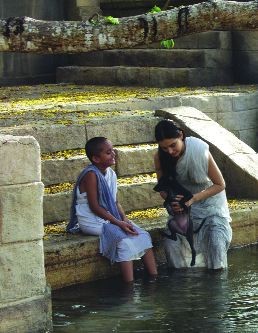Widowed in India

According to ancient Hindu texts, when a man dies, his wife has three choices. She can throw herself on his funeral pyre in the sacrificial act of suttee; she can marry her husband’s younger brother (if his family is willing); or she can spend her remaining days in isolation in an ashram designed for widows, where she shaves her head, wears mourning clothes and seeks to “atone” for her husband’s death.
Water is about a handful of women in 1938 India who end up in such a widow house, forced to live out their days doing menial chores, singing hymns on the street and begging for alms.
The tale begins with the arrival of eight-year-old Chuyia (Sarala), a child bride whose aging groom died hours after their wedding. Her terror and confusion as her parents leave, telling her that she will live the rest of her life there, set a creepy tone for the film. But Chuyia, as we soon discover, is a feisty child. She gets to know the women in the ashram, each of them representing a different stage of denial or acceptance of their fate.
The women are ruled over by the ruthless and cunning Madhumati (Manorama), the ashram’s Sydney Greenstreet, who keeps the operation afloat financially while turning a tidy profit for herself. She manages this in large part by sending out for prostitution the lovely Kalyani (Lisa Ray), who dwells apart from the other widows and is allowed to keep her long, beautiful hair for business purposes. At night Kalyani is ferried across the Ganges by Madhumati’s eunuch to spend the evening with British gentlemen and more “liberal” Indian Brahmins.
The main conflict in the story emerges with the arrival of Narayan (John Abraham), a handsome young Brahmin just out of university and a devout follower of Mahatma Gandhi. Gandhi was not only preaching modernism and nationalism (independence from England was still a decade away) but under the credo “Truth is my God” was fighting against traditions like the widow houses.
Narayan falls head over sandals in love with Kalyani, not knowing about her side job. He wants to marry her, much to the chagrin of his family, and of Madhumati, who doesn’t want to lose her meal ticket.
As this romantic subplot plays out, a far more intriguing story is developing between Chuyia and the middle-aged widow Shakuntala (Seema Biswas), a devout Hindu who has accepted her fate as God’s will. Watching Chuyia’s youthful spirit squelched, and realizing that Madhumati is grooming Chuyia to be Kalyani’s replacement, Shakuntala starts to question her lot in life. She become the moral center of the story, and is forced to make difficult choices at the end.
Water is written and directed by Deepa Mehta, an Indian-Canadian. It is the third part of her “elemental trilogy,” which includes Fire (1996), about a pair of lonely and needy Indian wives, and Earth (1998), about the partition of India and Pakistan in 1948. Mehta started shooting Water in 2000, but Hindu extremists got wind of the film’s content and protested, sometimes violently. Some sets were burned or tossed into the Ganges. Mehta had to shut down production. She returned to the project four years later, shooting on the sly in Sri Lanka, with an altered cast and crew.
The main player to stay with the project was cinematographer Giles Nuttgens, who also shot Fire and Earth. He has proven to be key to the success of all three films, finding inventive visual cues to express Mehta’s weighty themes and symbols. His use of blues and greens in Water is mesmerizing, as is his use of browns and golds in Earth and reds and oranges in Fire.
Much of the storyline is predictable, and the casting of two attractive former models in the romantic leads makes us feel that they are going to break out into song, Bollywood-style, at any minute. But the 57-year-old Mehta has been around the block a few times during her career. If it takes a few pretty faces to market a subtitled movie set in 1938 India, she’s willing to use them. There are 11 million widows in India still living in widow houses. Water seems to be dedicated to them.





